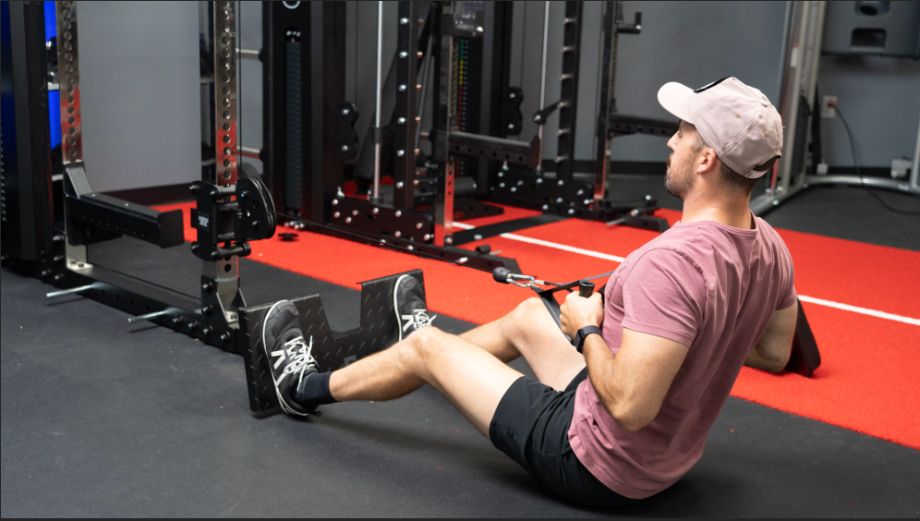We test and review fitness products based on an independent, multi-point methodology. If you use our links to purchase something, we may earn a commission. Read our disclosures.
The cable row is a fantastic exercise for building upper back strength in a safe, stable environment. However, if you’re new to resistance training or cable machines, it’s understandable that you might look at the exercise with some trepidation. Even if you’re years into bodybuilding or weightlifting, it’s a good idea to know exactly how to do the row. After all, performing the exercise incorrectly leaves you susceptible to injury.
As a certified personal trainer, I prescribe rowing exercises to my clients on a weekly basis. Here, I’ll break down for you exactly how to do a seated cable row as well as common mistakes to avoid.
(Psst: Don’t have access to a cable machine? Here’s a video on how to make your own pulley system at home.)
Why Do Cable Rows? 4 Benefits
In general, any version of a row is a great addition to your strength training routine. However, there are several good reasons to go specifically for cable rows:
Build Strength
Just like any other row, cable rows build upper back strength. They work muscles that include:
- The erector spinae (the muscles on either side of your spine that stabilize you)
- The latissimus dorsi (AKA your lats, AKA your wings, the muscles that help your shoulders move)
- The rhomboids (the muscles that help your scapula retract and protract as your arms move)
- The lower trapezius (the muscles the depress and retract the scapula)
The cable row also recruits other muscles, just to a lesser degree. Upper arm muscles like biceps and triceps are put to work more or less, depending on your grip. Your core also gets some attention, because even though you are seated, those stabilizers are hard at work keeping your body upright.
You can build muscle on the cable row through hypertrophy (doing several sets of six to 12 repetitions at moderate weight); or use it to build muscular endurance doing several sets of 15 or more reps at lighter weight.
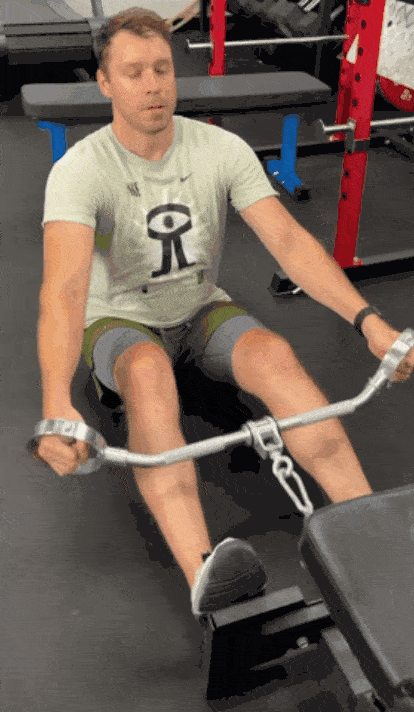
Stability
Unlike using dumbbells or barbells, using a cable machine provides increased stability for the lifter. You are in a seated position, which automatically decreases the odds of wobbling or falling during the movement. The anchored weights also increase the likelihood of a straighter movement path, which is optimal for reducing the risk of injury.
Isolate Muscles
Another benefit of doing rows on a cable machine is that you are isolating the exact muscles you want to work. In a bent-over row, you recruit muscles from your posterior chain, like your hamstrings, for stability. That isn’t a bad thing by any means; but, if you truly just want to isolate the upper back muscles, then a cable row eliminates the body’s need to recruit other muscle groups.
A Great, Portable Cable Machine
MaxPRO SmartConnect Portable Cable Machine
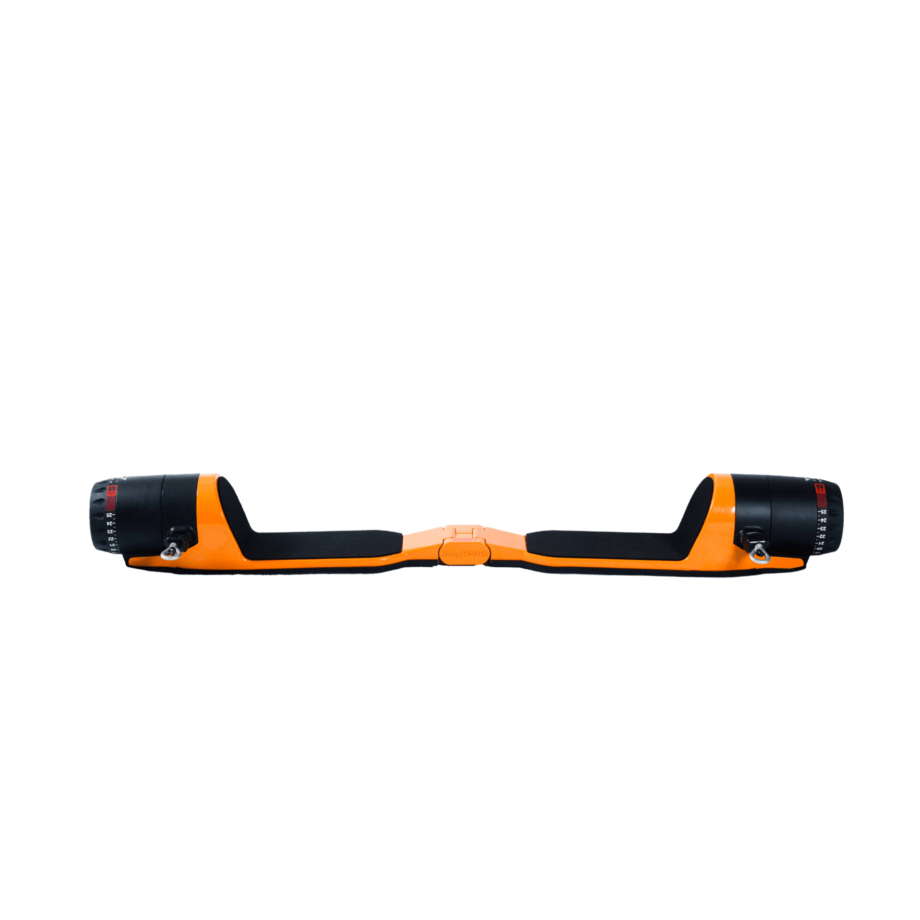
Product Highlights
- All-in-one machine that works different muscle groups
- Lightweight at 9 lbs
- Small footprint at 16″ L x 10″ W x 4″ H
- Produces resistance up to 300 lbs
Pros & Cons
Pros
- Lightweight
- Small footprint
- Produces resistance up to 300 lbs
Cons
- Pricey for a small piece of equipment
- Sub-par accessories
- Compatible app is not streamlined
Bottom Line
The MaxPRO SmartConnect Portable Cable Machine is a lightweight and portable full body machine, which offers up to 300 pounds of resistance. This makes it an extremely versatile piece of portable equipment with a small footprint.
Safety
Machines have long been a safe haven for people new to resistance training, those recovering from injuries, or those simply looking to minimize risk. Why? Because machines provide stability and a straighter path through the range of motion.
But also, a cable machine uses a pulley system to connect you to the resistance. What happens if you drop the attachment on a cable machine at a bad time? A loud bang from the weight stack slamming a few feet away from you. What happens if you drop a barbell or dumbbell at a bad time? Depending on how close that weight is to you, it could mean a serious injury.
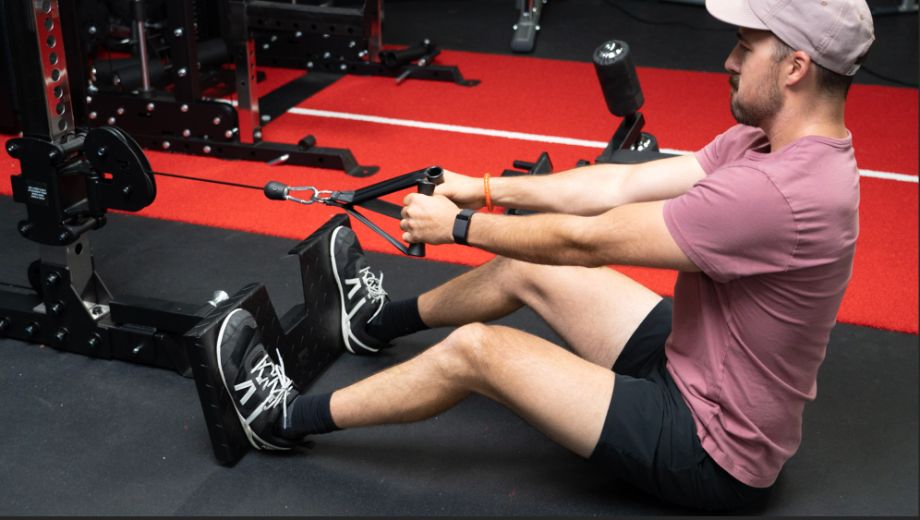
How to Do a Seated Cable Row
The seated cable row is simple enough for beginners but allows for maximum strength-building for gym veterans. If you’re looking to add it to your workout routine, here’s how to do it properly:
- Pick the right attachment: In most cases, this is a V-grip attachment, though you can do seated rows with a straight bar and EZ bar, depending on which muscles you want to target most.
- Select the appropriate weight for your fitness level. When in doubt, start light and add weight if the exercise is too easy.
- Set the pulley to your chest height when you are in the seated position.
- Sit upright with your legs in a slight bend and feet on the pads. If there are no pads, make sure you are seated at a height where your feet are firmly planted on the ground.
- Grasp the attachment with arms fully extended directly in front of you.
- Set your shoulders down and back (retracting the scapula).
- Maintain good posture, sitting upright, as you pull the attachment into your lower abdomen, squeezing your shoulder blades together behind you.
- Pause for a moment, then return the attachment to your starting position with control.
Mistakes to Avoid
Just like with any other lift, proper form is paramount. If you aren’t sure if you’re moving correctly, have a personal trainer or friend watch you. You can also video yourself to watch the playback, looking for these common mistakes:
- Moving without control: You control the weight, it doesn’t control you! Move with intention and purpose instead of allowing the weight to pull you back into the machine.
- Leaning forward: While a slight hinge at the hip is acceptable, leaning forward too much takes tension away from the muscles you want to target (and potentially strains the muscles in your lower and middle back).
- Moving your torso: This isn’t a row machine in the cardio sense; your arms should be moving, not your torso, which will protect you against an injury in your lower back.
- Rounding your upper back: Your shoulders should be pulled back and down, not rounded forward excessively, as you return the weight to the starting position.
- Cutting the movement short: The full range of motion is for your arms to start in a fully extended position, then for the attachment to touch your lower abdomen, and to return the arms to full extension
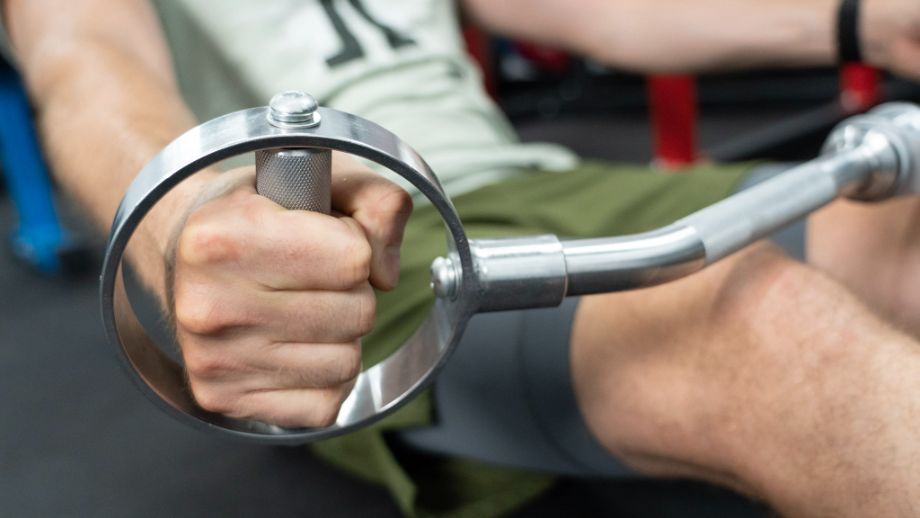
Which Attachment Should I Use for a Seated Cable Row?
If you head to a commercial gym, or if you just have an unbelievable home gym of your own, you might have a number of attachment options for the seated cable row. There is really no wrong answer here when it comes to which to pick, it just depends on your preferred target muscles.
V-grip
Arguably the attachment most people use for the cable row, the V-grip (also known as a “double-D”) places your hands in a neutral grip. You’ll target your lats, traps, and rhomboids, using a little bit of bicep as well.
Straight Bar
I love a good straight bar for rows, because you can do the exercise with either an overhand (pronated) or underhand (supinated) grip. Overhand will feel a lot like using a rowing machine, as the narrow grip allows you to hit the rear deltoids (the muscles on the back of your shoulders) as well as your lats and traps. If you want to use more biceps while doing your rows, simply switch your grip to underhand.
RELATED: Rowing Machine Workouts
Rope
The rope is a highly versatile attachment, giving you an even bigger range of motion as you can pull the rope wide across your torso. This will engage your lats more while still calling on the rhomboids, traps, and biceps.
Wide Bar
If you have a bar used for lat pulldowns, you can use it for a seated row. Taking a pronated wide grip (hands out wide, gripping overhand) will work your lats more. If you want to target more biceps, use an underhand grip.
Modifications
One of my favorite things about exercise is that it’s available to everyone. There are always modifications to make to accommodate injuries, fitness level, or special concerns.
With the seated cable row, there are a few ways to make the exercise easier, harder, or simply more accessible:
- Start light: If you’re new to lifting weights, a good rule of thumb is to find a weight where you can do 10 to 12 reps at moderate effort levels for two to four sets. Build from there.
- Banded rows: If you can’t yet move the weight stack on the cable attachment, then use a resistance band, gradually increasing resistance until you can move to the machine.
- Single-arm cable row: If you have an injury on one side of your body, you can use the stirrup attachment to perform rows with just one arm. Technique is the same, but just one arm works.
- Use different attachments: The V-grip attachment is one most people use because a neutral grip tends to feel best. If you want to make the exercise more challenging, you can always add weight or try wide grip cable rows or rope rows.
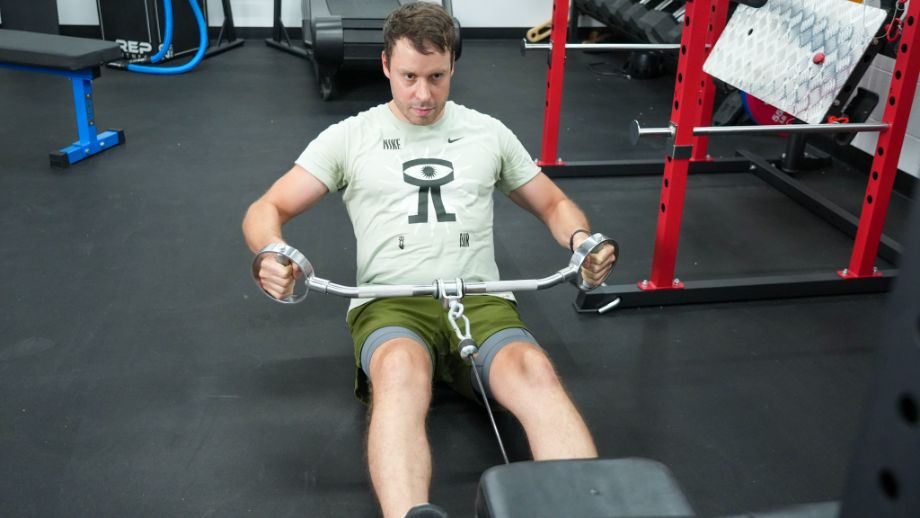
Alternatives to Seated Cable Rows
If you don’t have access to a cable row machine, there are plenty of other pulling exercises that build muscle in your back (along with potentially hitting other muscle groups). These are just a few of the best back exercises out there.
Final Thoughts
If you want to get stronger, specifically in your back, then the seated cable row is an excellent choice. Before you put the pin in the weight stack and start pulling, make sure you have proper form. And if you need a modification or an alternative, there are plenty out there!
Great Value: Compact Cable Machine
Vitruvian Form Trainer+
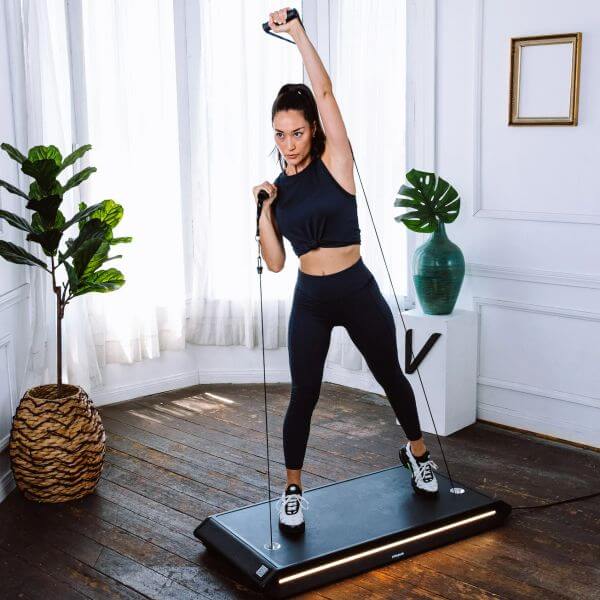
Product Highlights
- Adaptive weight system that produces weight from 0 to 440 pounds
- Advertised as working similarly to a rack without having to change plates or store any of the weight
- The technology will do it all for you
- However, different from a squat rack, you are able to do over 200 different exercises that target all parts of your body
- All Access Membership costs $39 per month.
- Without the Trainer All Access Membership, you are still able to work exercises and create your own workouts.
Pros & Cons
Pros
- Full functionality of the machine is available without a subscription (i.e. access to all workout modes)
- 30-day money-back guarantee
- 1-year all-access app membership for in-depth data tracking included with purchase (at the time of publish)
- Free shipping
- Provides up to 440 pounds of resistance
- Small and compact
- Relatively easy to move and store
- Workouts led by certified instructors
- Adaptive weight changes as you work out
- Community challenges and leaderboard
- Tracks several workout metrics
- Can easily view progress
- Safe and controlled way to exercise
- Provides exercise technique tutorials
- 1 membership allows unlimited profiles
- Lifetime membership available
- Financing available via Affirm
- Can create your own workouts or follow classes
Cons
- Expensive, as all smart gyms are, with prices starting around $2,900
- Subscription required for in-depth data tracking after trial period ($39/month)
- Accessory kits sold separately
- No hour-long workout classes yet (sessions go up to 43 minutes)
- Can be overwhelming to create your own workouts in the app at first, according to our product tester
- Buyers are responsible for return shipping if sending the item back
Bottom Line
The Vitruvian Trainer+ is a smart home gym with a fantastic value proposition. For most people, it can replace an entire traditional home gym set up while taking up minimal space and providing and opportunity for in-depth data tracking and coaching.
Seated Cable Row FAQs
What muscles does seated cable row work?
You’ll hit most of the muscles in your upper back, shoulders, and arms doing a seated cable row:
Lats
Upper traps
Rear delts
Biceps
Rhomboids
Erectors
To some degree, muscles in your core are activated, though mostly through an isometric contraction (a muscle contraction in which the muscle doesn’t lengthen or shorten; much like your abdominal muscles working during a plank).
Why should I train the seated cable row?
There are lots of row exercises out there, but the seated cable row provides ample stability and safety while isolating your back muscles.
Is it okay to round the upper back during the seated cable row?
You should keep your back straight while performing rows. You might round your back slightly as you protract your shoulders to return the weight to the starting position. While this isn’t something I would purposely tell people to do, it is something you might see as people stretch to get a full range of motion. An overly rounded upper back is what could lead to injury.
Further reading

Is a multi-collagen supplement right for you? Find out in our Ancient Nutrition Multi Collagen Protein review, featuring insights from our third-party lab testing. Read more

After ample research and testing, these are our picks for the 10 best weight loss programs for women, including apps, meal delivery services, and supplements. Read more

After rowing tens of thousands of meters, we’ve rounded up the best rowing apps to use alongside your machine. Read more

What do you really know about the crunches exercise? GGR’s own Amanda Capritto provides tips for proper form and more! Check it out! Read more

